15 Style Points For Your Next Highboy
Proof That No Two Rods Are Alike
Photography: Rick Amado
There’s no denying that hot rods are largely about aesthetics. The problem is, with a huge palette of components to choose from, it’s way too easy to create bad art. As magazine guys, we’re supposed to maintain the illusion that hobby cars are individualistic expression, and that no one is supposed to dub anyone else’s automotive vision as right or wrong. Still, gross errors like wrong stance, wrong colors, and wrong wheels, or more minute details like headlight placement and windshield rake, can make the difference between a stunning vibe and a total mess.
As we embark on a Deuce highboy project, visualizing our roadster as a whole is critical before we start loading up the credit card. As we considered the minutia and the affect they have on the overall feel of the car, we realized that we’ve never seen a checklist of things to consider for mainstream hot rod styling. So that’s our goal with this story.
Rod styles are so vast that we had to set some limits. First, we decided to stick with highboys. That means we’re also focusing on the most common ’28-’34 Fords, though the info applies to coupes, roadsters, and sedans. We’re also narrowing in on the parts and components that are commonly available from the chassis companies and the aftermarket at large rather than delve into the possibilities of custom creations. This will cover the more traditional looks of the ’40s through the very early ’70s, albeit sometimes with a contemporary twist.
1: Wheels and Tires
This is perhaps the most critical of all choices, and owning several styles of rubber and rims can totally change the look of your car. Upon the initial build, you need to decide if you want tall-and-skinnies or bigs-and-littles. Tall and narrow tires always require traditional wheels—generally steelies with caps, Kidney Beans, or trad wires—and bias-ply tires that can be whitewalls or not. In some cases all four tires are the same size, but more often they’re 5.50-16s on the front and 7.00-16s (or so) on the rear. Bigs and littles can range from modern radials to retro ’70s meats and the variety of acceptable wheel options is far greater.
2: Stance
A highboy is inherently high, with the body atop the frame rather than channeled over it. However, you can go with a ’40s-style tall-and-level stance, a ’50s medium-high stance with a bit of a rubber rake, a full-on ’70s stink-bug stance, or a modern way-low attitude with a bit of rake. The choice goes hand in hand with the wheel and tire combo.
3: Suspension
Omitting the high-tech look with independent suspension on the front or even both ends still leaves a lot of choices for a solid axle front end. Do you want an I-beam (more retro) or a tube axle (more modern)? Should the I-beam be drilled? Should the axle be painted, detail-painted, or chromed? Do you prefer a 46-inch or 48-inch wide axle? There’s also the consideration of how it should be located depending on the vintage you want. They are, in order from earliest to latest: split wishbones or split and drilled wishbones, hairpins, or a four-bar. As for a suspension, a multileaf transverse spring is most traditional, followed by a monoleaf spring, then a more contemporary coilover setup (usually used with a tube axle and a four-bar). The rear suspension is less noticeable, but should follow the theme. Coilovers and a four-link are less trad than a transverse leaf and ladder bars.
4: Frame
Initially, the frame will need to accommodate the stance and suspension you’ve chosen. The crossmember location fore and aft and up-and-down will determine the wheelbase and ride height and give the car its general look. Additionally, if you’re working with a Model A, the choice between an A frame or a ’32-style frame is critical; we suggest the latter for a fenderless car. A ’32 frame generally needs to be pinched to look right with a narrow Model A cowl, but even if you’re using a Deuce frame under a ’32, you’ll generally pinch the front rails a bit so that there’s no gap between the hoodsides and the frame (if you’re running a hood). Total Cost Involved uses a “mild pinch” or “wild pinch” depending on the hood-to-frame look you want and the engine clearance you need.
You also need to decide if the front and rear framerails will be bobbed even with the body in the front or rear. If so, the gas tank will need to be mounted elsewhere (it was originally between the rear framerails behind the body), probably in the trunk just behind the seat. If you retain the front and rear frame horns, then you need to decide what type of spreader bars you want (painted or stainless? V’ed or straight?), plus whether the front horns will be boxed or not. The consideration to box the horns or not may also affect the placement of turn signals and taillights.
5: Engine
The mill is a big factor in the personality of the car. Are you going retro flathead, monster blown Hemi, or boring small-block Chevy? The decision will affect things like the suspension choice (for both ride height versus engine weight and also for traction and safety versus horsepower), hood choice (Do you hide it or show it off? Will hoodsides even fit?), and exhaust (for style or practicality). If you decide to run without a hood or hoodsides, the engine needs to match the era or vibe of the rest of the car. If the engine is hidden, you can get away with stuff like fuel injection on a retro-looking car. Without a hood, forget it.
6: Exhaust
Regardless of the engine choice, how will you run the exhaust? You can choose from Limefire-type headers, Sprint Car style tubes, or zoomies. Any of those can be run open, with muffler inserts, with sidepipes or “track” pipes, or with bypass tubes that run to mufflers under the car. Or you can be more subtle and keep it all under the car. Don’t forget that sound will also contribute to the aura of your highboy.
7: Hood Options
There are quite a few things that will determine hood and hoodside selection, including the engine, the exhaust, and the vintage you want. You can run just a hood top and no sides, or you can run a top and sides. You need to choose from a one- or two-piece top (the latter is more trad, the former more smoothie), plus decide if you want louvers or not. Rootlieb hoods offers three- or four-piece hoods with no louvers, tall louvers in 20- or 25-slot designs, three- or four-row top or side louvers, and hoodsides with high-tech scoops. You can even mix and match. Hoods are also available to mate Model A bodies with ’32 grilleshells, and don’t forget to consider neat stuff like toolbox latches or leather straps on your hoodsides. If you’ve stretched the wheelbase a bit to fit a long engine, we suggest you leave the hood off to keep the car from looking like Pinocchio.
8: Headlights
Lots of important detail here, including headlight size and location. King Bee lights, industrial lights with integral turn signals on top, and large stock-type ’43 lights are all options. The 4-inch-round lights can be fluted, smooth, or loaded with Jag-type tri-bars. You have to decide if you want a headlight bar or not. Lights can also be mounted on custom F-1 shock-mount-style pedestals, aftermarket equivalents, or from custom tabs on the shock towers. The typical aftermarket ’50s/’60s-type cast-aluminum ribbed headlight stands are also a good choice for small lights, but they usually hang them too far outboard for the modern eye. Light location is critical as far as up and down and fore and aft. Mess with it.
9: Grille
If you have a Model A, will you keep the stock grille or go Deuce? For a ’32 grille shell, will it be filled or keep the stock ornament? Are you going to use a spear down the center of the hood? If the shell is filled, will it be peaked or smooth? As far as the grille insert goes, you can get it with or without the crank hole, and it can be painted, stainless, or chrome. Or you can paint the vertical ribs and leave the surround bright. If you’re working on a Model 40, the selection of ’33 or ’34 grilles is also critical—and expensive!
10: Body Baubles
Right off the bat your highboy better not have cowl lights. Beyond that, it’s debatable. On a Model A, you can keep or lose the gas cap in the cowl. On a ’32, the same goes for the cowl vent. Most guys keep the door hinges these days, but they can also be smoothed. A roadster usually doesn’t have door handles or a deck handle, but it might if the style is old enough, while coupes usually retain that stuff unless they are high-tech. The use of external rearview mirrors is also up for debate on a roadster, but peep mirrors are common on coupes and sedans.
11: Taillights
Only the high-tech crowd will opt for third taillights and LED strips in the roll pan. The traditional crowd will usually opt for ’39 Ford teardrops, ’50 Pontiac roundies, or ’60s-style rectangular lights that are somewhat out of vogue.
12: Windshield
On a coupe or sedan, you’ll only choose between stock-type or high-tech flush-fit glass. For a roadster it’s a bit more in-depth. A 2-inch chop on the stock frame and posts is most common, but you can do more or less depending on the mood. Altering the rake of the stock windshield components can also set the tone, as can the choice to run the chrome channel atop the glass or omit it. Gaining in popularity are Duvall-style V’ed windshields from Speedway Motors and Wescott’s, and you can get them with a trad split or with more modern V-butted glass. So-Cal also has a new one-piece windshield, and the very retro guys can make a Hallock-type V-glass.
13: Dash
The interior sets the style more than you may suspect, and we’ve seen many retro rods tinged by a modern interior or vice versa. The dash can use an Auburn insert, a vintage S-W setup, a neo-retro damascened gauge cluster, or more high-tech billet offerings. Don’t overlook the installation of a ’40 Ford dash or even a narrowed art deco setup from your favorite funky ’50s car. The steering wheel should match the theme: banjo, ’40 Ford, ’59 Impala, Bell-style, or modern. Brand new columns are available for all of them and are preferable to ripping a tilt-tele column from a ’70s Cad or Olds.
14: Upholstery
We set the upholstery separate from the dash because, on a roadster, it affects the look quite a bit. An overstuffed seat on a stock tack rail screams ’70s, while nearly any car built today is considered smoother with the seatback tucked under the tulip panel. You can still opt to leave the wooden tack rail or remove it. The seat color, stitch pattern, material, and even the shape will largely affect the mood of the car. We feel that textured or patterned inserts are the next big thing.
15: Paint
Finally, the most obvious. While colors come and go, it’s important to match the tone with the theme of the rest of the car. An extreme Kandy Tangerine just isn’t right on a ’40s car, and a high-tech rod may not be right in a ’50s Palmolive green or eggplant purple. Don’t get caught in current color trends or the car will be quickly dated. Same with graphics. Remember when everyone ran out and put ’80s scallops on everything? Match the detail to the style.
|
|
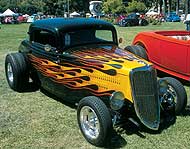
This Model 40 is a perfect example of transcending eras. It’s a traditional rod with a solid axle and flames, yet clearly a modern-times car with big radials and polished Torq-Thrust IIs. With a full four-piece hood, it could be equally good with a tri-power small-block, an EFI setup, or a dual-quad billet big-block.
|

Here’s a trad ’40s style: a ’27 T on a Model A frame with an A ’banger and ’35 wires. Note the stock high-and-level ride height and the original mechanical brakes.
|
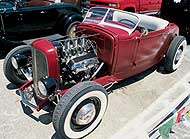
This ’30/’31 on ’32 rails with a Deuce grille is pure late-’50s thanks to bias whitewalls on steelies and a Duvall-style windshield.
|
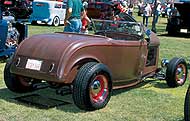
This ’32 exemplifies bobbed rear frame horns with a roll pan, ’39 teardrop taillights, and a custom three-piece hood with 25-louvre hoodsides.
|
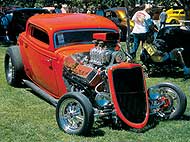
If this isn’t Guy Ruchonette’s old coupe, then it’s a mimic that screams mid-’80s—the era of overpowered, over-rubbered rods like Fat Jack’s ’46 coupe and Jerry Moreland’s ’40 Tudor. The huge rear meats fall shy of Pro Street. This is a look that will come back soon.
|
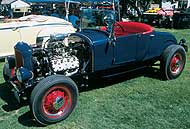
This ’28/’29 on ’32 bones uses a retro flathead with a Thickstun-style air cleaner. The heavily padded seat on the stock tack rail is an example of the upholstery style seen clear through the ’50s.
|

Here we’re moving high-tech, denoted by the sculptured hoodsides, bobbed front rails, smoothed hinges and handles, and wide radials all the way around.
|
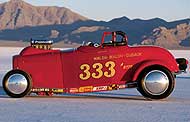
The true Bonneville style is rarely seen in today’s street rods as it was in the past. This ’32 has all the trimmings of a current land-speed racer and could easily form some ideas for a street car.
|

This is a modern rendition of the Doane Spencer car done quite true to style. Of note is the Duvall windshield, the taller-than-trendy ride height with a rubber rake, the padded seat, and the headlight bar.
|
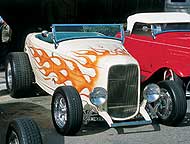
Another example of the modern traditional style, this ’32 roadster makes interesting use of color; it’s an example of how the interior choice helps make the car stand out. This is also a good example of the increasingly popular placement of big, tight, and low headlights.
|
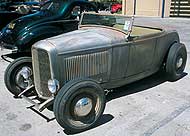
Street Rodder magazine’s Chris Shelton owns this Brookville-bodied, So-Cal chassis ’32 with traditional 550-16s and 700-16s on steelies. The hood is a trad four-piece with 25-louver sides. A lower-than-retro ride height tips off that this is a modern car, but it works.
|
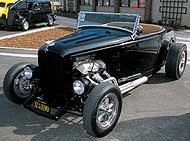
This shot and the next one identify the power of just a few changes. It’s the same ’32 roadster, but the tan wire wheels lend a far stodgier look than the slicks and skinnies on original Torq-Thrust wheels.
|

Also note that the interior was altered from the ’70s stuffed look to a smoother modern seat. The car also has a ’40 dash, which is slightly incongruous with the side-exhaust and the Chevy W-motor, but we like it anyway.
|
|



 15 Style Points For Your Next Highboy
15 Style Points For Your Next Highboy
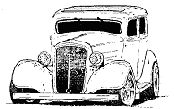


 15 Style Points For Your Next Highboy
15 Style Points For Your Next Highboy